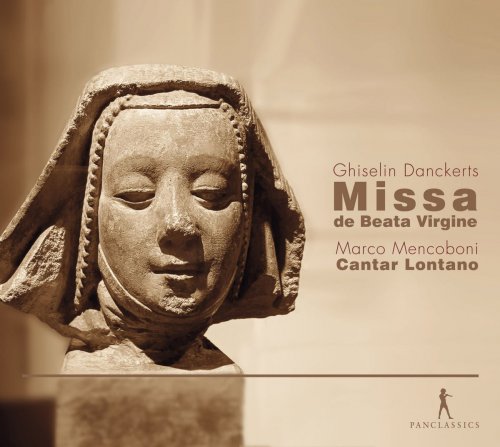Cantar Lontano & Marco Mencoboni - Dankerts: Missa de Beata Virgine (2018)

Artist: Cantar Lontano, Marco Mencoboni
Title: Dankerts: Missa de Beata Virgine
Year Of Release: 2018
Label: Pan Classics
Genre: Classical
Quality: flac lossless +booklet
Total Time: 00:51:15
Total Size: 282 mb
WebSite: Album Preview
TracklistTitle: Dankerts: Missa de Beata Virgine
Year Of Release: 2018
Label: Pan Classics
Genre: Classical
Quality: flac lossless +booklet
Total Time: 00:51:15
Total Size: 282 mb
WebSite: Album Preview
---------
01. Missa de Beata Virgine: I. Gaudeamus omnes in Domino
02. Missa de Beata Virgine: II. Kyrie
03. Missa de Beata Virgine: III. Gloria
04. Missa de Beata Virgine: IV. Assumpta est Maria
05. Missa de Beata Virgine: V. Credo
06. Missa de Beata Virgine: VI. Felix namque es
07. Missa de Beata Virgine: VII. Sanctus
08. Missa De Beata Virgine: VIII. Agnus Dei
09. Missa de Beata Virgine: IX. Beata viscera Mariae Virginis
Composers
Danckerts, Ghiselin (c.1510-67)
Ghiselin Danckerts (c 1510 –1567) was a Dutch composer, singer, and music theorist of the Renaissance. He was principally active in Rome, in the service of the Papal Chapel. Nothing is known of his early life. Like many of his contemporaries from the Low Countries, he may have received his early training in his homeland, going to Italy as a young adult. He was admitted as a singer at the Papal Chapel in March 1538, a position he retained, seemingly without break, until 1565. In August 1565 he was forced to retire from the papal chapel as part of a reorganization and reduction in size which followed from the reforms of the Council of Trent.
A few works of Danckerts have survived, but no complete publications – one motet, an eight-voice setting of Laetamini in domino, survives in a manuscript; other surviving works include several madrigals and puzzle canons. The here recorded Missa de Beata Vergine has recently come to light. It is a polyphonic mass with improvised elements, as was customary for most of the Gregorian repertoire at this time in Rome. The plain chant (i.e. the Gregorian melody) was laid in the lowest voice and the other parts would have sung the same melody on top of that, at a consonant interval. In this way, the result was a pyramidal structure where the sopranos and tenors could freely improvise ascending and descending runs.
![Juan Torres Fernández - Azul Cristalino (2025) [Hi-Res] Juan Torres Fernández - Azul Cristalino (2025) [Hi-Res]](https://www.dibpic.com/uploads/posts/2025-12/1765496468_y7dxox9hmk6hb_600.jpg)
![Chewing, Dave Harrington, Ryan Hahn, Spencer Zahn - Quintet (Live in Los Angeles) (2025) [Hi-Res] Chewing, Dave Harrington, Ryan Hahn, Spencer Zahn - Quintet (Live in Los Angeles) (2025) [Hi-Res]](https://img.israbox.com/img/2025-12/12/owakjkfg0whflv2rzyocno89p.jpg)
![Collin Walcott - Cloud Dance (1976/2025) [Hi-Res] Collin Walcott - Cloud Dance (1976/2025) [Hi-Res]](https://www.dibpic.com/uploads/posts/2025-12/1765538423_cover.jpg)

![Nābu Pēra - Soundscapes of Nicosia (2025) [Hi-Res] Nābu Pēra - Soundscapes of Nicosia (2025) [Hi-Res]](https://img.israbox.com/img/2025-12/14/lhs20jten1ip5ht0uibyjocfe.jpg)


![Amira Kheir - Black Diamonds (2025) [Hi-Res] Amira Kheir - Black Diamonds (2025) [Hi-Res]](https://www.dibpic.com/uploads/posts/2025-12/1765640459_tf7wrmc9lqmqc_600.jpg)
